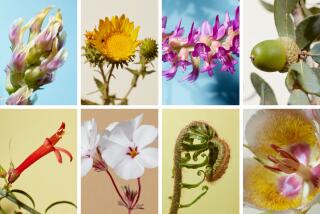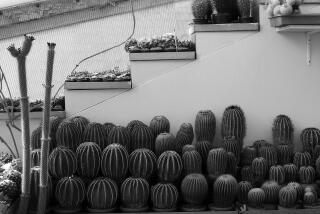Book Review : This Plant Study Will Not Grow on You
- Share via
People of the Desert and Sea; Ethnobotany of the Seri Indians by Richard Stephen Felger and Mary Beck Moser (University of Arizona: $65)
Early in this century, when science was less self-conscious, less mesmerized by statistics, and probably more human, this book might not have been published in this form--big, handsome, crammed with information, and ultimately empty.
For here lay an opportunity. The authors have an intriguing subject, the Seri people, inhabitants of a particularly arid region along the Gulf of California. The Seris, perhaps best known as creators of ironwood sculpture, have not yet been homogenized into Western industrial culture but remain a hunting and gathering society even this late into the 20th Century.
In setting out to write an ethnobotany, a study of this people’s idiosyncratic understanding of the plant world, the authors touch upon a potential key to the culture: The living desert provides the Seris not only with their food but their shelter, their fuel, their medicines, their clothes, their toys, their glue--plus the pigments they paint their faces with, their musical instruments, the raw materials of their basketry and sculpture, even their myths, their religious rites and their gods.
View of the World
In such a culture, more integral than ours, study of the Seri understanding of plants opens into their entire view of the natural and supernatural worlds.
The authors--Felger is a research scientist at the University of Arizona’s Office of Arid Land Studies, Moser a linguist--are manifestly knowledgeable about the Seri and aware of the marvels abiding in this material. Dutifully they provide sections on Seri religious rites, Seri art and Seri gods. And still they waste their opportunity.
They write English as though it were their second language, and academese their first. To wit:
“The total Seri flora of 427 plant names can be grouped into 310 ethno-genera. Eighty-two percent (255) of the ethno-genera are monotypic, the remaining 18% (55) are polytypic (two or more ethno-species) and contain 127 ethno-species (Table 5.3). Botanical classification places the 55 ethno-genera and 172 ethno-species into approximately 115 genera and 174 species. . . .”
If such writing doesn’t make you weep, be warned that virtually everything is given its scientific name in Latin, and that measurements are translated into the metric system for inconvenience. So a small plant becomes not a comprehensible size like the length of your thumb, or even a couple of inches long, but four-point-something centimeters long. Which communicates nothing without an unnecessary trip to the dictionary.
Pictures, Tables, Facts
Result: We are offered lots of pictures and tables and charts and fact upon fact upon fact, but no understanding. A scientist looking for data may do well here. So may a back-to-the-earther looking for recipes. A reader seeking to understand an alien people will only rediscover how useless information is without insight.
No, ethnologists need not turn their research into romance, as Frank Waters did in “The Book of the Hopi” or into fantasy, as Carlos Castaneda did in his Don Juan books--disservices to the Hopi, the Yaqui, and to millions of readers.
But how about a return to some of the goals and values of ethnologists earlier in this century, when scientists were not machines recording data but humanists struggling toward enlightenment?
More to Read
Sign up for our Book Club newsletter
Get the latest news, events and more from the Los Angeles Times Book Club, and help us get L.A. reading and talking.
You may occasionally receive promotional content from the Los Angeles Times.










